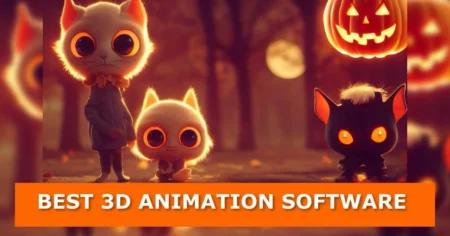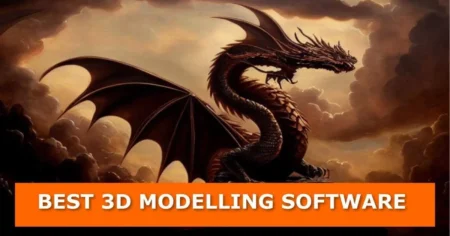If you’re a fan of 2D animation, you might be wondering which software is best for bringing your creative ideas to life. Whether you’re making cartoons, explainer videos, motion graphics, or game assets, the right software can make all the difference.
With so many options available, how do you decide which one suits your goals, budget, and experience level? This blog post breaks down the best 2D animation software for 2025, making it easier for you to choose.
1. Toon Boom Harmony
Toon Boom Harmony is an industry favorite, used in shows like Bob’s Burgers, Star vs. the Forces of Evil, and Rick and Morty.

Why Choose It?
- Ideal for both rigging and frame-by-frame animation
- Wide variety of brushes for detailed work
- Supports bitmap and vector-based drawing
- Advanced compositing tools built-in
- Great for professional productions with large teams
- Industry-standard software used by major studios
- Integration with storyboard and production management tools
Toon Boom Harmony is available in three versions: Essentials, Advanced, and Premium. Each offers different levels of features, allowing animators to choose the best fit for their needs. Harmony’s robust feature set makes it the go-to software for major animation studios worldwide. Its integration with storyboarding software and effects tools also makes it highly efficient for production pipelines.
Who Is It For?
Professional animators, studios, and those looking for high-end production quality.
Pricing: Comes in three versions—Essentials, Advanced, and Premium—each with different levels of features.
Get Toon Boom Harmony: https://www.toonboom.com/products/harmony
2. Adobe Animate
Used in The Amazing World of Gumball and Super Science Friends, Adobe Animate is great for puppet animation and swapping assets efficiently.

Pros:
- Easy-to-use brush tools
- Ideal for creating character rigs
- Integrates with other Adobe Creative Cloud apps like Photoshop and After Effects
- Interactive animation features for web and game development
- Regular updates with new features
Adobe Animate is particularly strong in creating HTML5 animations and interactive content. It’s widely used for web animations and educational content, making it a favorite among designers working with digital media. Although it has a limited number of advanced raster brushes, its vector tools allow for smooth animation that scales well across devices.
Cons:
- Only available via subscription
- Limited raster brush options compared to competitors
Who Is It For?
Artists and animators working with interactive animations, YouTube creators, and game designers.Get Adobe Animate:https://www.adobe.com/creativecloud/plans.html
3. TV Paint
Used in feature films like The Breadwinner and shorts like The Dam Keeper, TV Paint is perfect for those who love traditional, hand-drawn animation.

Why Choose It?
- Designed to mimic classic hand-drawn animation
- Great for detailed frame-by-frame work
- Customizable interface
- Advanced layering system and effects
- No reliance on vectors, making it feel more organic
Who Is It For?
Traditional animators, independent filmmakers, and animation professionals.
TV Paint is highly regarded for its ability to recreate the organic feel of traditional animation. Its raster-based drawing tools allow animators to work with incredible detail, making it ideal for those looking to achieve a painterly or hand-drawn look. It’s used in various professional animation studios worldwide due to its extensive toolset and powerful customization options.
Pricing: One-time purchase with Standard and Pro versions.
Get TV Paint:https://www.tvpaint.com/v2/content/article/store/prices.php
4. Moho formerly Anime Studio Pro
Moho is a vector-based animation software with strong rigging capabilities and a more affordable price tag than Toon Boom Harmony.

Why Choose It?
- Smart bones system for smooth animations
- 3D camera and depth effects
- Affordable compared to other professional animation software
- Great for character rigging and cut-out animation
- Intuitive interface with automation tools
Moho is well-known for its vector-based animation tools that make it easy to create smooth motion. The software’s smart bones feature reduces the need for traditional frame-by-frame animation by allowing users to create fluid character movements with minimal effort. This makes it an excellent choice for those looking for a balance between efficiency and quality.
Who Is It For?
Independent animators, small studios, and artists looking for an alternative to Toon Boom Harmony.
Get Moho:https://moho.lostmarble.com/
5. Clip Studio Paint
Initially designed for manga and illustration, Clip Studio Paint has evolved to support animation as well.

Features:
- High-quality drawing tools for frame-by-frame animation
- Onion skinning and timeline support
- Pro and EX versions available (EX required for full animation features)
- Available for iPad via subscription
- Cloud storage and syncing available
- Advanced pen stabilization and texture brushes
Clip Studio Paint has gained popularity among animators due to its highly customizable brushes and smooth drawing experience. While the Pro version is excellent for illustration, the EX version unlocks full animation capabilities, making it a great budget-friendly alternative to more expensive animation software.
Who Is It For?
Illustrators, storyboard artists, and animators who want a hybrid of painting and animation tools.
Pricing: One-time purchase or subscription model.
Get Clip Studio Paint: https://www.clipstudio.net/en/purchase/
6. Photoshop
Though not built for animation, Photoshop has a basic timeline and various plugins to enhance its capabilities.

Pros:
- Excellent brush variety
- Customizable frame-by-frame animation
- Integrates well with Adobe After Effects and Animate
- Great for cel animation and concept art
Cons:
- Not as intuitive for animation as other software
- Requires Adobe Creative Cloud subscription
Who Is It For?
Illustrators, concept artists, and animators working within the Adobe ecosystem.
Get Photoshop: https://www.adobe.com/products/photoshop.html
7. OpenToonz
Used in Mary and the Witch’s Flower, OpenToonz is a free, open-source animation tool with powerful capabilities, though it has a steep learning curve.

Why Choose It?
- Free and open-source
- Professional-level animation tools
- Customizable with plugins
- Used by major Japanese studios
Get OpenToonz: https://opentoonz.github.io/e/
8. Blender
Originally for 3D animation, Blender’s Grease Pencil tool allows for 2D/3D hybrid animation, as showcased in the short film Hero.

Why Choose It?
- Fully free and open-source
- Powerful 2D animation tools within a 3D workspace
- Constant updates and improvements from the Blender community
- Great for experimental and hybrid animation
Get Blender: https://www.blender.org/
9. Sketchbook
Sketchbook is a lightweight and intuitive animation tool, perfect for beginners and casual animators.

Why Choose It?
- Free with an option for an affordable pro version
- Clean and easy-to-use interface
- Great for hand-drawn animations and sketches
While Sketchbook lacks advanced animation tools, it’s perfect for roughing out ideas and simple animations. The minimal learning curve makes it an excellent choice for artists transitioning into animation.
Get Sketchbook: https://www.sketchbook.com/
10. Krita
Krita is a free, open-source digital painting program with a surprisingly robust animation feature set.

Why Choose It?
- Extensive brush engine with realistic textures
- Powerful frame-by-frame animation tools
- Free and open-source
Krita’s animation tools are constantly improving thanks to community contributions. It’s a great budget-friendly option for artists who want a Photoshop-like experience with solid animation capabilities.
Get Krita: https://krita.org/en/
11. Synfig Studio
Synfig Studio is a powerful free and open-source vector-based animation software with an advanced bone system for character rigging.

Why Choose It?
- Free and open-source
- More than 50 layers for complex animations
- Bone system for natural movement
- Vector-based for infinite scalability
Get Synfig Studio: https://www.synfig.org/
12. Pencil 2D
Pencil 2D is an open-source, beginner-friendly 2D animation program.

Why Choose It?
- Simple interface for easy learning
- Supports both raster and vector workflows
- Free and cross-platform
Although it lacks advanced features, Pencil 2D is perfect for those looking to start animating without investing in expensive software.
Get Pencil 2D: https://www.pencil2d.org/
13. Animation Paper
Animation Paper is a work-in-progress animation tool designed for traditional animators.

Why Choose It?
- Focused on hand-drawn animation workflows
- Clean and intuitive interface
- Free while in beta, with an affordable price planned for launch
This software is still in development, but it promises to be an exciting option for traditional animators looking for an intuitive and lightweight tool.
Get Animation Paper: https://animationpaper.com/
14. Adobe After Effects
Adobe After Effects is a powerful and versatile software that can create stunning motion graphics and visual effects for your videos. It is a 2.5D software, which means it can combine 2D and 3D elements in the same scene. You can use After Effects to animate text, logos, characters, shapes, and more.

Why Choose It?
- Advanced motion graphics and compositing tools
- Seamless integration with other Adobe software
- Great for adding special effects and transitions
After Effects allows animators to create complex visual effects, making it an industry-standard for motion design. It’s perfect for combining 2D and 3D animation elements, making it ideal for high-end productions.
Get Adobe After Effects: https://www.adobe.com/products/aftereffects.html
15. Adobe Character Animator
Adobe Character Animator is a powerful desktop application that seamlessly combines real-time live motion capture with a multi-track recording system.
It allows creators to control layered 2D puppets based on illustrations drawn in Photoshop or Illustrator.

Adobe Character Animator brings 2D characters to life with real-time motion capture.
Features:
- Live facial tracking for real-time animation
- Seamless Photoshop and Illustrator integration
- Great for streaming and interactive content
This software is ideal for animators who want to create expressive characters without spending hours on traditional keyframing.
Get Adobe Character Animator: https://www.adobe.com/products/character-animator.html
Conclusion
With so many great 2D animation programs available, there’s something for everyone—whether you’re a beginner or a professional.
Which animation software do you use or plan to try? Let us know in the comments! If you found this post helpful, share it with your fellow animators and check out more of our content here: https://gachoki.com/blog/.







I really appreciate your work. the whole point very easy to understand. Please keep us up to date like this.
Hi Kamran
Thank you for the kind words. We promise to continue doing our best to post content that is interactive and informative.
2D animation software such as Pencil2D, Krita, OpenToonz, and Synfig Studio allows artists to create traditional hand-drawn or digital animations.
They offer tools for frame-by-frame drawing, timeline editing, and special effects, suitable for beginners to professionals.
Thanks for the input.